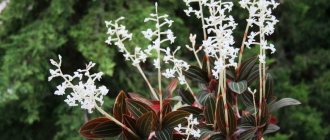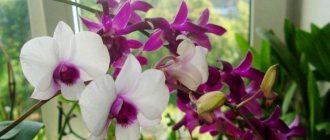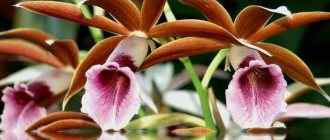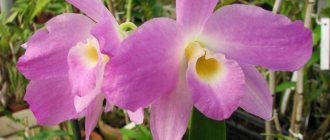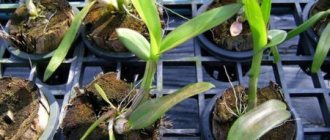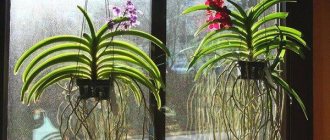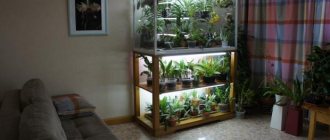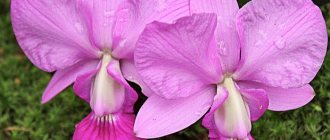Orchids do not leave anyone indifferent. Natural forms and their hybrids are popular and loved for their exotic beauty and long-lasting flowering.
Among them is the dendrobium orchid Berry Oda. The genus Dendrobium has more than 900 representatives. Under natural conditions, these orchids grow in rock crevices and on tree trunks.
The natural habitat of Dendrobium is Asia, Australia, and the Pacific Islands. Numerous hybrids have been created based on the dendrobium orchid. This variety is no exception.
Types of dendrobium orchids and hybrids
Dendrobium is a genus of deciduous and evergreen plants of the Orchidaceae family. Natural habitat - Asia, Australia, New Zealand and the Pacific Islands. More than 900 species are united under the name Dendrobium, among which there are both epiphytes and lithophytes.
The most common varieties and varieties:
- Dendrobium nobilis is an epiphytic plant found wild in the highlands of Southeast Asia. On tall, erect shoots of the orchid, lanceolate leaves with a glossy coating develop. During the flowering period, arrows topped with several large, fragrant flowers appear from the axils of the leaf blades. The color is varied: it can be monochromatic or combined.
- King's Dendrobium is a compact and undemanding species native to the Australian continent. The plant develops as a lithophyte. Several shoots with sessile leaves grow from the pseudobulbs. Peduncles are a continuation of the stems. They bloom with beautiful flowers of white, red, pink and lilac colors.
- Dendrobium "Berry Oda" is a hybrid that can easily tolerate higher temperatures compared to other species. Thickened stems emerge from the pseudobulbs. The flowering period, during which many small flowers bloom, can last about six months. "Berry Oda" is compact and does not exceed 40 cm.
- Dendrobium "Sa-Nuk" is the fruit of the work of Thai breeders. It is distinguished by its ability to bloom again after 5-7 months. The inflorescences resemble the common phalaenopsis orchid.
- Dendrophalaenopsis is an orchid with pseudobulbs, from which erect stems with lanceolate green leaves develop. Flowering is abundant: up to 20 flowers can bloom on each peduncle. The older the plant, the more inflorescences it has.
Important!
Dendrobium Berry Oda is a species hybrid of Dendrobium kingianum and two other natural species. It owes its long flowering and delicate aroma to the latter.
Characteristic features of the variety
Berry Oda is a hybrid variety of Dendrobium King crossed with Dendrobium Mini Pearl. The latter, in turn, is obtained from the natural species Canaliculatum and Bigibbum.
Instead of roots, the plant has pseudobulbs. Thick, erect stems grow from them, the height of which is a maximum of 40 cm. They have narrow lanceolate leaves, in adult plants - mainly in the upper part. The color of the leaf plate is characteristic of orchids, green. But the aerial roots that dendrobium produces over time are lighter and thinner than those of phalaenopsis.
At the beginning of summer, the bush forms flower stalks with racemose lush inflorescences. The flowers themselves are small, no more than 1 cm in diameter, but bright; their color cannot be described in one word. There are purple, crimson, lilac tones and even white. The inflorescences emit an intoxicating sweet aroma reminiscent of lilac. Flowering lasts until autumn, but sometimes dendrobium can bloom in winter. Moreover, quite often the children formed on the stems bloom. This explains the large number of flower stalks.
Berry Oda is a typical representative of lithophytes and in natural conditions grows on stones, between tight cracks.
Conditions and care
To decorate the windowsill with an exotic plant, it is necessary to provide comfortable conditions for the dendrobium orchids. In addition, it is important to properly care for the tropical beauty - organize a proper watering regime and fertilizing.
Temperature and lighting
To place a container with a flower, set aside a place on the windowsill of an east or west window. Dendrobium needs plenty of bright light. But direct sunlight is harmful to it. In winter, the plant should be provided with additional lighting for 5 hours.
Keeping temperature – 25 °C. After the pseudobulbs ripen, it is recommended to keep the flower in a room with temperature values in the range of 12-15 °C.
Soil and container
It is better to grow dendrobium in a clay pot. It is more stable. The volume of the container must correspond to the root system of the plant.
To fill the pot, use a substrate made from a mixture of orchids, moss, pieces of pine bark, a small amount of pumice and perlite. The latter can be replaced with coarse river sand. To prevent the roots from rotting due to stagnant moisture, be sure to organize drainage from a thick layer of pine bark.
Watering and humidity
Moisturize the orchid moderately. During the period of active growth, the frequency of watering is once a week. Before a new portion of water, the humidity of the substrate should be controlled: the roots must have time to dry out. In winter, after the pseudobulbs ripen, watering is practically stopped.
If the apartment has high temperatures, the humidity should be increased. At the same time, it is necessary to systematically ventilate the holding room, otherwise pathogenic fungi may begin to develop.
Feeding and fertilizer
In spring and summer, the plant is fed twice a week. Complex fertilizers are used as nutritional compositions. Prepare the solution as described in the instructions on the package, depending on the drug. From mid-autumn until the end of winter, you should not feed the orchid.
Transfer
The flower is rarely replanted - if the soil is highly salinized, the roots are rotting due to overwatering or a cramped pot. The optimal time for transplanting the Berry Oda hybrid is when the new shoots reach a height of 5 cm, when they begin to develop their own roots.
Important!
Dendrobiums are painful to endure the transplantation procedure. You should take this into account when choosing a new container so that after a year it does not become small.
Description
Dendrobium is a large genus due to its huge number of plant species. They differ:
- buildings;
- sizes;
- flowers;
- appearance of plants.
The shape of the stems is cylindrical, reed-like or spindle-shaped. Dimensions range from 20 cm to two meters. In home apartment conditions, height does not exceed 60 cm.
The root system is aerial roots covered with loose outer tissue that can absorb and accumulate moisture. Leaves have different shapes. There are oblong, narrow-lanceolate (wide at the base with an elongated sharp end), and elliptical. Some species have leaves with dense succulents, which provide an abundant supply of moisture.
Note! Orchids have racemose inflorescences, multi-flowered. There can be several options for arrangement: straight, hanging type of inflorescence. There are lateral locations.
According to the flowering period, the orchid is one of the flowers for which this period lasts from two to seven to eight weeks.
Propagation of the Berry Oda orchid
The plant is bred vegetatively. You can resort to cuttings or divide the mother bush when transplanting.
In the first case, parts of the shoots with several internodes are cut and buried in a special substrate for orchids. The cuttings are covered with plastic caps and wait for the roots to appear. When this has happened, new specimens can be planted in permanent pots.
When dividing the mother bush, the children are planted in separate containers. The pots are placed for several days in a room with soft light and a temperature of at least 22 °C.
Reproduction
Reproduction is possible only by vegetative means. Plant seed is difficult to obtain. It germinates slowly and does not have the characteristics of the mother plant. Of the vegetative methods, there are three options. The most accurate way is to cut off the baby at the top of the pseudobulb. Be sure to make sure there are roots on them.
Using cuttings, several new plants are obtained. They are rooted in sphagnum moss, sprayed periodically. Before planting, be sure to dry the cuttings in the fresh air. The easiest way for gardeners is to divide the mother bush into daughter bushes. This happens when transplanting from a cramped pot.
Among the huge colors, shapes, sizes, flowers have some identical properties. Most often it is a pleasant aroma. Inside the flower you can see fused leaves neatly folded around a column. The column is small in size, short in length. Small lateral leaves grow from it.
Basic rules of care
It is believed that caring for dendrobium is easy. But this is only from the point of view of an experienced gardener. Caring for any orchid is specific. All varieties, without exception, require systematic, attentive, responsible care.
- Lighting. Keep in good lighting, but protect from the sun. The best placement option is a south window. The remaining windows require lighting. Placement on a north window is contraindicated. In the spring, with the onset of stable warmth, you can take the dendrobium out onto the loggia. Fresh air does him good. The temperature at night should not fall below 7˚C. Light intensity affects leaf color. Dark green color is a sign of lack of light. If the lighting is too bright, they become light green. Yellow leaves are a sign of severe light deficiency, which is dangerous for the plant.
- Temperature. At the active growth stage, the optimal daytime temperature is 25˚C, night temperature is 20˚C. A daily temperature difference is required - without this, the dendrobium will not bloom. Can't stand heat above 30˚C. In autumn the temperature decreases. Daytime should be about 20˚C, night - 10˚C.
- Watering. Water abundantly after the soil has completely dried. It is believed that it is correct to water the dendrobium by immersing the pot in a container of warm water for 10–15 minutes. After excess liquid has drained, the flower is returned to its original place. With the appearance of new leaves on the tops of the sprouts, watering is temporarily suspended. They are renewed only after the appearance of flower buds.
- Humidity. Artificial air humidification is required only in summer. In hot weather, the dendrobium is sprayed with warm, soft water from a small spray bottle. In winter, spraying is not necessary and even dangerous. High humidity combined with cold leads to rotting of the roots.
- Feeding. Fertilizers are applied from the beginning of flowering until the final formation of new shoots. Use mineral complexes for orchids. Fertilizers are diluted in water for irrigation. Sometimes it is useful to carry out foliar feeding by spraying. For the first and last feeding, the amount of fertilizer is taken half as much.
- Priming. Universal soil mixtures are not suitable for planting orchids. Dendrobium is planted in a mixture of peat, pieces of coniferous bark, birch charcoal and sphagnum moss. The substrate is first sterilized - poured with boiling water or calcined in the oven. Before adding to the mixture, the bark is soaked for two days, followed by rinsing in clean water.
- Transfer. There are good reasons to transplant a dendrobium orchid. He takes it very hard. Indications for replanting are salinization of the substrate, turning it into dust, constriction of the roots. Replant at the end of February or beginning of March.
Dendrobium aerial roots should not be immersed in the substrate. They actively participate in photosynthesis and gas exchange. If the pot is placed on a tray of wet pebbles, the roots may stretch down in search of additional support and moisture.
Orchid Dendrobium Berry Oda: planting and care, features of the variety
Dendrobium is one of the varieties of the popular orchid flower. It is distinguished by a large number of hybrid varieties. Not demanding in care, easy to grow. The literal translation of dendrobium is living on a tree. But these flowers can grow independently on the ground and stones. Trees are used as support. The buds are varied in size and color. Flowering time is long. In tall varieties, plant trunks are completely covered with flowers.
